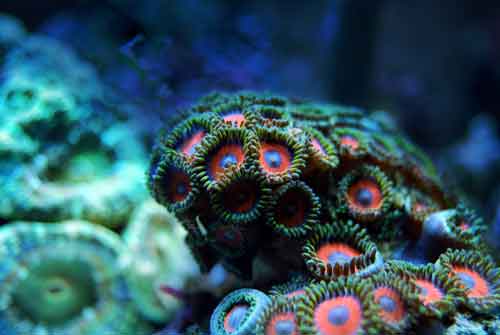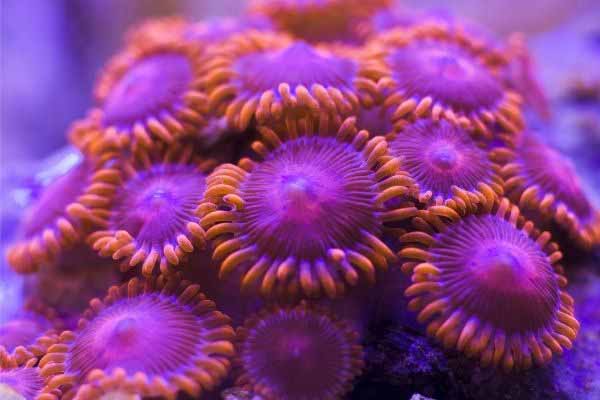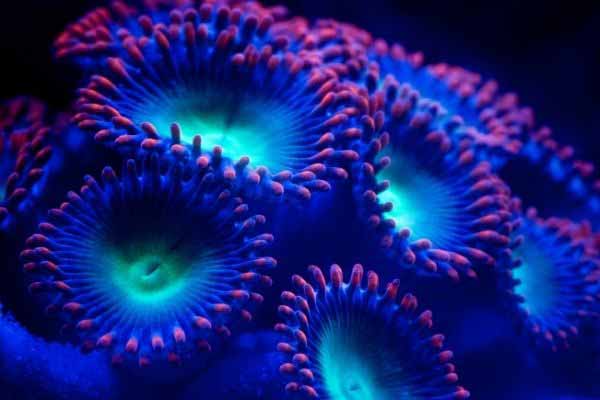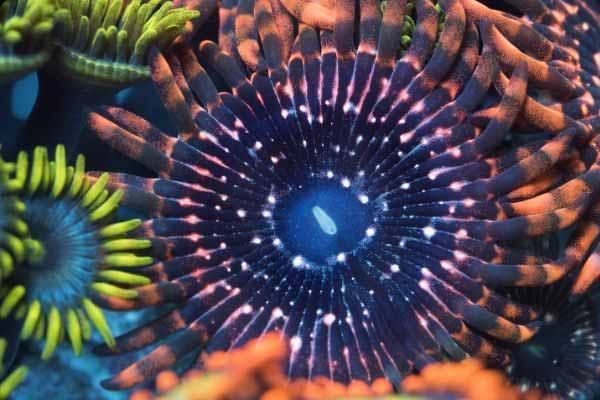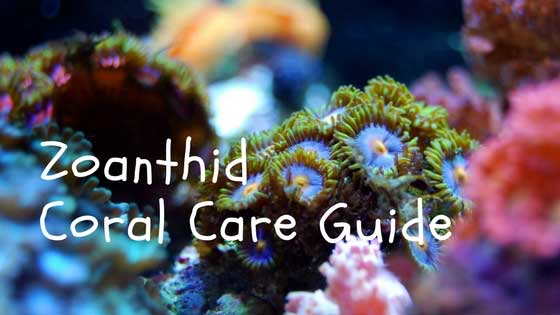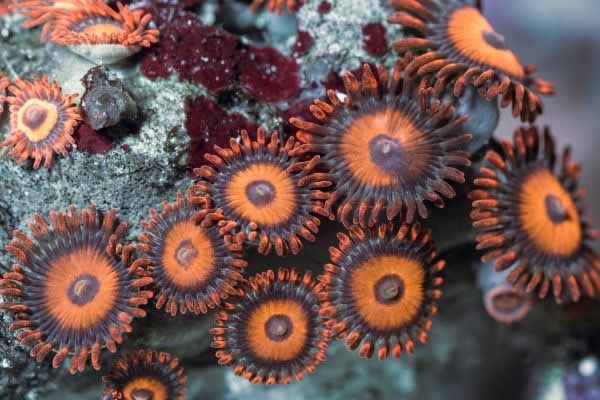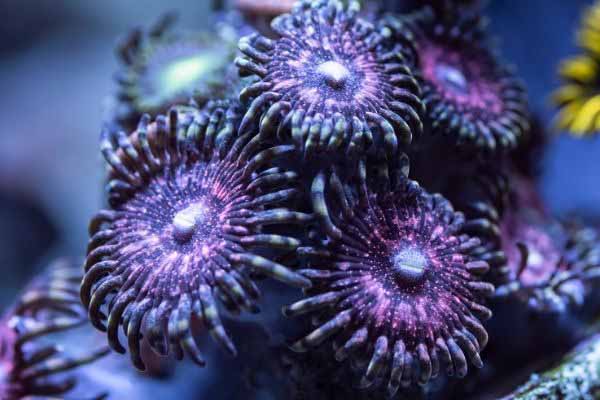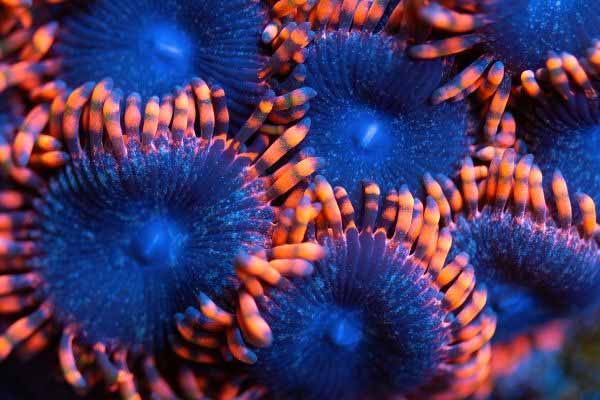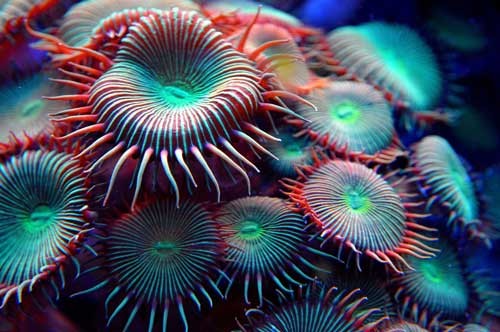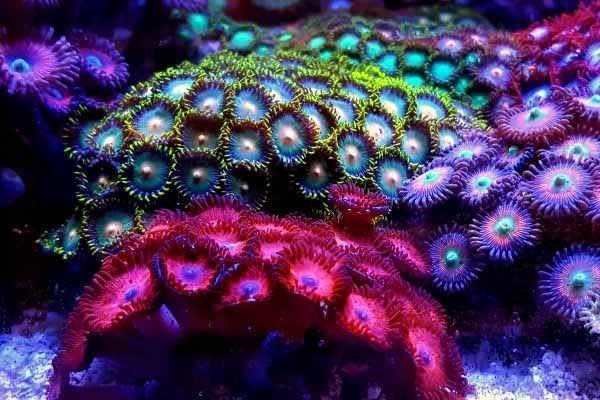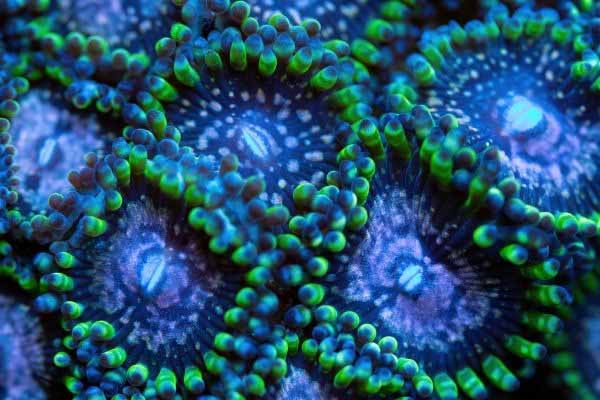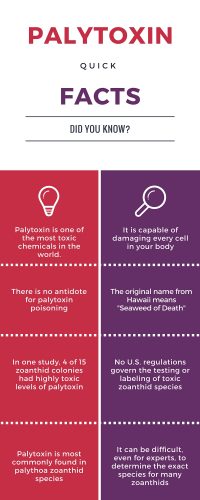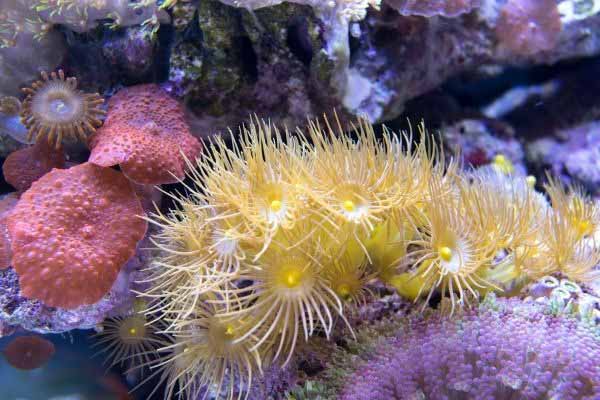[ad_1]
Zoanthids coral, affectionately called zoas by aquarium hobbyists in online forums (I guess because zoanthid coral is too long to type) is an extremely popular type of coral kept in reef tanks.
Why?
Because they are relatively easy to grow, maintain, frag, AND they are available in amazing, brilliant, fluorescent colors.
They are hardy and will grow well in most reef tanks, which makes them a great soft coral for beginners.
A quick point about geeky zoas taxonomy and zoanthids coral id (identification)
The term “zoanthids coral” tends to be used casually in the saltwater aquarium hobby, the large group of colonial coral button polyp animals. As is the case with other closely related organisms and the baffling diversity we see on our reef systems, there remains some debate about the individual categorization of specific members of this group. I will attempt to characterize these classification buckets in two ways:
- Their growth form, or the way the colony grows
- The Genus in which they belong (at least for now, or at least at some point…)
One of the primary ways to determine what genus and species a Zoanthid colony belong to is to determine the growth form of the colony. There are three common colonial growth forms:
- Massive or Mat
- Connected
- Individual/solo
You can hopefully see this relatively well illustrated in the image below.

Note the thick mat of button polyps on the left with he oral disk barely poking out, compared with the polyps in the middle connected by a reasonably thick stolon, but with stalks extending up, and finally, on the right, the long stalks and individual, or nearly individual bases
Massive or Mat colony formations
These zoas generally belong to the Palythoa genus and are identified by the existence of a very thick mat, called a coenchyme or mesoglea. You can tell just by looking at them that the mat is thick and substantial, making up a large amount of the weight/matter of the entire colony. Some species will incorporate bits of rock, sand, or other matter to help make the mat even more substantial and structurally supportive/tough (Borneman 2001).
Connected
The next way some Button polyp Genera grow is connected at the base by a thin mat or runner. This thinner connective tissue is called a stolon.
Solo or Individual
The last growth form is exhibited by certain genera that grow with individual stalks that are not generally connected at the base.
Four popular Genera (plural form of the word Genus)
Now that we know how the various Zoanthid polyps grow, with respect to the relative connectedness to their colonies, it is helpful to note that there are 4 groups (called Genera) of Zoanthid corals that you will find in the aquarium hobby:
- Palythoa
- Protopalythoa
- Zoanthus
- Parazoanthus

Parazoantus, Zoanthus, Protopalythoa, and Palthyoa are 4 genera of button polyps you might see in the hobby. Not the differences in appearance and growth form
Feeding zoas
The majority of zoanthids have symbiotic photosynthetic zooxanthellae (I dare you to try and say that three times quickly) and are therefore best kept with at least moderate aquarium lighting. Some of the more brightly colored morphs will tolerate even intense lighting from metal halide or newer generation LED lights if acclimated properly.
Most species are capable of actively capturing prey. For the fastest growth of these corals, it is recommended that you feed them periodically with an appropriately sized food, although feeding is not usually required.
Target feeding these zoanthid coral polyps is fairly straightforward.
- If you’re using a small particle food like Reef Roids, you want to mix a small scoop of the dry food with a small bit of tank water, so that the food/water mixture is thick and almost pasty.
- Turn off all of your aquarium pumps.
- Then, using your Sea Squirt, Julian’s Thing, pipette, or turkey baster, you want to suck up the pasty food and very gently place a small amount of food particles on each polyp, as close to the center of the polyp as you can.
- For the most part, less is more here, you don’t want to overfeed. As you get the hang of it, you can gradually increase the amount of food, once you’re sure your corals are eating it, but when you first star out, it is best to feed them very lightly.
- On many zoanthids, you can actually see the mouth slit–that’s the bullseye (or more likely, the zoanthidmouth), you’re aiming for.
Since the food mixture is generally thick and heavier than the water, it should gently fall on the polyp. The polyps will then very slowly fold inward, the mouth will open, and the food will go inside. This is the fastest and best way to grow these corals. Don’t forget that corals are animals–and animals like to eat. Yes, they can and do get some of their energy from the symbiotic zooxanthellae that live inside their tissue, but that is only half of the story. You will be rewarded with strong growth if you feed them regularly.

Chucky’s Bride zoanthids: pink and yellow/lime with a white mouth slit. They don’t look like a horror show to me
If your polyps won’t eat, try changing up the size and type of food you are offering. Borneman reported that some individuals would only respond to certain food prey items.
Placement of zoa corals
Place zoa corals in an area of low-medium to medium-high flow. Too much flow may make it hard for the polyps to open. You will know your zoanthids are ‘happy’ if they open up and are fully extended without seeming to stretch so far upright.
This is a generalization–and generalizations can be problematic in some specific instances, but look to the vibrancy of the color of the coral as an indication for how much light the coral needs (and therefore a reflection on where to place the coral in terms of proximity to the brightest lights). The more intense and fluorescent the color is, chances are good that means the more intense the lighting has been for that coral so far. The more dull, drab or darkly colored, the more shaded the zoanthid coral has likely been.
The best-case scenario, in terms of zoanthid placement, is to know how and where the coral was placed most recently (if it came from a fellow hobbyist tank, for example)–and if happily growing–try to recreate that in your tank. That is, of course, unless you know your placement will be that much better.
Zoanthid Lighting
Most zoanthids are rather forgiving/tolerant of different lighting and being placed just about anywhere but the most shaded or (opposite) brightest positions in the tank. Many of the most popular “name brand” zoas, like fruit loops, orange bam bam, fire and ice, and whammin’ watermelon have eye-popping colors that will pop best when placed under the actinic lights.
You could place them higher in the water column, too, assuming you properly acclimate them to the light intensity, if you don’t have more light-hungry corals in your tank.
Water parameters for zoas
Zoanthids require the standard water parameters that are good for keeping just about any of your corals healthy. You’re aiming for tropical water temperature (about 78 F), normal ocean salinity (somewhere around 1.025 specific gravity), normal hardness (8-12 dKH) and a pH around 8-8.4.
For more information about the most important reef tank aquarium water parameters, check out one of my most popular articles here.
The key to keeping water parameters in the right range is to start with a high-quality salt mix. You can read a review of a few of the most popular salt mixes here.
Troubleshooting problems: zoanthids not opening
Some of the more rare and delicate zoanthids may take a couple of days to open up after transportation to your home. If you just bought your polyps, don’t worry if they won’t open up right away.
However, if your polyps were previously open and have recently closed up, this should be taken as a serious sign of a water parameters issue. The first things I would check are salinity and pH. In my experience, zoas will close up if there are swings in salinity. I originally read about this in the book: Practical Coral Farming.
Zoanthid coral for sale
You will find these for sale at any respectable local or online fish store. Prices will vary for just a few dollars ($5-10) for a small frag all the way up to the max you will want to pay for a high-end designer coral with a fancy name like Orange bam bam or purple hornet zoanthids, which can sell for $100 or more for every coral polyp.
Top Zoanthids to Buy
Top Zoanthid Types
One of the most fun aspects of keeping zoos in your saltwater aquarium is to collect polyps from the hottest color morphs. They have ridiculous sounding names that seem to make perfect sense once you see them.

Whammin watermelon is a very popular zoa type–as you can see why
If you’re just getting started, here is a list of some of the names you can start with to begin your search to find the perfect zoas for your reef tank.
- Fruit Loops
- Purple People Eater zoas
- Orange bam bam
- Purple hornet zoos
- Blueberry field zoas
- Fire and ice
- Whammin’ watermelon zoos
- Sunny D’s
- Rasta zoos
- Red Hornets
- My Clementines
- Blue Hornet
- Radioactive dragon eyes
- Utter chaos
- Blue Agaves
- Night Fury zoas
- Captain America zoos
- Candy apple red zoanthus
To see what some of these zoanthids look like, take a look at this eye-candy video with a ranking of the top 10 most popular zoanthids.
Rare Zoanthids
Over the last few years, there has been a bit of a zoanthids collector mania, driving up the prices of rare zoanthid color morphs. These rare zoanthids go by names like bubble buster, tazer, tyree space monster, and bloodshots.
These corals are for the ultimate collectors with a lot of money, dreams of coral propagation, and an I gotta have it gene. These corals are so expensive and so popular there are forum threads that discuss the street value of these corals. You can’t make that stuff up.
Danger: toxic palytoxin
Several species of polyps produce a toxic chemical, called palytoxin, and so individual specimens should be handled with extreme care. Palytoxin can cause neurological damage if it gets inside of a cut, your eyes, or in your nose or mouth. Always wear protective gear when handling zoanthids, including gloves and goggles.

These zoanthids were collected from the tank of an aquarist who suffered from exposure to palytoxin. Source CDC website
Not every variety of zoanthid coral creates palytoxin, but be sure to let friends and family members know about it, just in case you ever run into an issue. A great way to do that is to document the issue in the back of your reef journal and to let your family know it is there.
Zoa coral melting or dying back
Have you noticed that your zoanthid coral is dying back? There are a few common things to look for in helping troubleshoot why your zoas are dying
Diseases: Zoa Pox
One disease that seems to disproportionately impacts these corals is something called zoa pox or zoanthid pox. Zoa pox is the name given to the zoanthid disease characterized by tiny growths on the side of the affected zoas. I’m not sure whether the growths/pustules themselves irritate the polyps and cause them to close up, or if the coral is otherwise sickly and closed up (therefore showing the zoa pox), but the bottom line is that if you see zoa pox, you have a sick coral.
How do you treat zoa pox? One thread suggests hobbyists have been successful using Furan-2, which suggests zoa pox may be bacterial in nature (because Furan-2 is an antibiotic).
Someone has been eating my porridge zoas
Another common problem with keeping zoas is predation–sometimes the culprit is that someone has been eating your zoanthids. If you notice that your otherwise healthy zoanthids start disappearing, there are two things to look for. Watch carefully to see if one of your fish has acquired a taste for these polyps. Often times, otherwise reef safe fish like some butterflyfish, rabbitfish, or angelfishes can acquire a taste for coral polyps. Other times, the root cause of the disappearing act is from small invertebrates, like zoanthid eating nudibranchs. Just be careful not to throw the nudibranch out with the bathwater. Not all nudibranchs are bad–some, like the Berhgia nudibranch, eat only aiptasia anemones.
Conclusions
If you are interested in hardy, fast-growing, brightly colored corals (and who isn’t?) then there is probably a perfect zoanthid for you. Be sure to wear protective gear and always wash your hands when handling them and most of all, take pictures and enjoy.
Written by Albert B. Ulrich III- Sign up for the SaltwaterAquariumBlog Newsletter and follow me on Twitter and Facebook
What to read next
If you are looking for other amazing corals to add to your tank, check out:
[ad_2]
Source link

